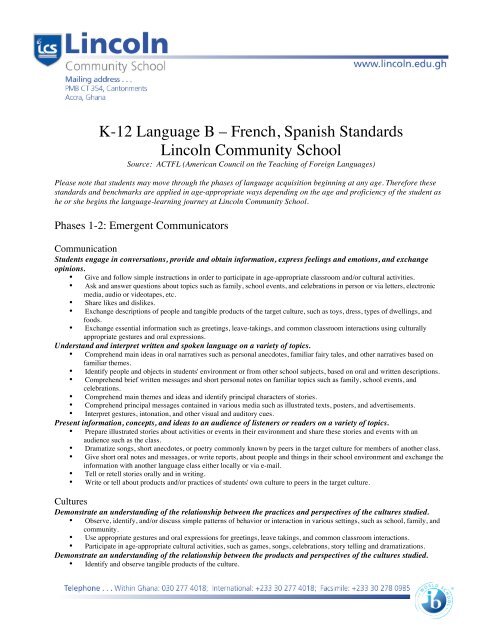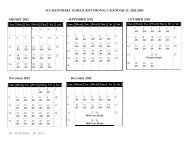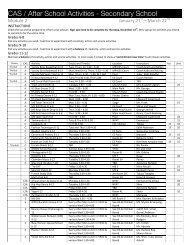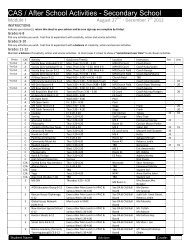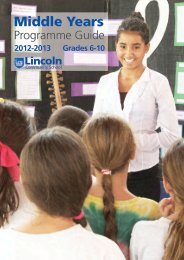French/Spanish - Lincoln Community School
French/Spanish - Lincoln Community School
French/Spanish - Lincoln Community School
Create successful ePaper yourself
Turn your PDF publications into a flip-book with our unique Google optimized e-Paper software.
K-12 Language B – <strong>French</strong>, <strong>Spanish</strong> Standards<br />
<strong>Lincoln</strong> <strong>Community</strong> <strong>School</strong><br />
Source: ACTFL (American Council on the Teaching of Foreign Languages)<br />
Please note that students may move through the phases of language acquisition beginning at any age. Therefore these<br />
standards and benchmarks are applied in age-appropriate ways depending on the age and proficiency of the student as<br />
he or she begins the language-learning journey at <strong>Lincoln</strong> <strong>Community</strong> <strong>School</strong>.<br />
Phases 1-2: Emergent Communicators<br />
Communication<br />
Students engage in conversations, provide and obtain information, express feelings and emotions, and exchange<br />
opinions.<br />
• Give and follow simple instructions in order to participate in age-appropriate classroom and/or cultural activities.<br />
• Ask and answer questions about topics such as family, school events, and celebrations in person or via letters, electronic<br />
media, audio or videotapes, etc.<br />
• Share likes and dislikes.<br />
• Exchange descriptions of people and tangible products of the target culture, such as toys, dress, types of dwellings, and<br />
foods.<br />
• Exchange essential information such as greetings, leave-takings, and common classroom interactions using culturally<br />
appropriate gestures and oral expressions.<br />
Understand and interpret written and spoken language on a variety of topics.<br />
• Comprehend main ideas in oral narratives such as personal anecdotes, familiar fairy tales, and other narratives based on<br />
familiar themes.<br />
• Identify people and objects in students' environment or from other school subjects, based on oral and written descriptions.<br />
• Comprehend brief written messages and short personal notes on familiar topics such as family, school events, and<br />
celebrations.<br />
• Comprehend main themes and ideas and identify principal characters of stories.<br />
• Comprehend principal messages contained in various media such as illustrated texts, posters, and advertisements.<br />
• Interpret gestures, intonation, and other visual and auditory cues.<br />
Present information, concepts, and ideas to an audience of listeners or readers on a variety of topics.<br />
• Prepare illustrated stories about activities or events in their environment and share these stories and events with an<br />
audience such as the class.<br />
• Dramatize songs, short anecdotes, or poetry commonly known by peers in the target culture for members of another class.<br />
• Give short oral notes and messages, or write reports, about people and things in their school environment and exchange the<br />
information with another language class either locally or via e-mail.<br />
• Tell or retell stories orally and in writing.<br />
• Write or tell about products and/or practices of students' own culture to peers in the target culture.<br />
Cultures<br />
Demonstrate an understanding of the relationship between the practices and perspectives of the cultures studied.<br />
• Observe, identify, and/or discuss simple patterns of behavior or interaction in various settings, such as school, family, and<br />
community.<br />
• Use appropriate gestures and oral expressions for greetings, leave takings, and common classroom interactions.<br />
• Participate in age-appropriate cultural activities, such as games, songs, celebrations, story telling and dramatizations.<br />
Demonstrate an understanding of the relationship between the products and perspectives of the cultures studied.<br />
• Identify and observe tangible products of the culture.
2<br />
• Identify, experience, or read about expressive products of the culture, such as songs, selections from literature, and<br />
artwork.<br />
• Identify, discuss, and produce artwork, crafts, or graphic representations.<br />
• Recognize themes, ideas, or perspectives of the target culture.<br />
Connections<br />
Reinforce and further knowledge of other disciplines through the foreign language.<br />
• Demonstrate an understanding of concepts learned in other subject areas in the target language, including weather,<br />
mathematics, measurements, animals, insects, and geographical concepts.<br />
Acquire information and recognize the distinctive viewpoints that are only available through the foreign language<br />
and its cultures.<br />
• Read, listen to, and talk about age-appropriate school content, folk tales, short stories, poems, and songs, written for native<br />
speakers of the target language.<br />
Comparisons<br />
Demonstrate understanding of the nature of language through comparisons of the language studied and the<br />
students’ own.<br />
• Cite and use examples of words that are borrowed in the language students are learning and their own, and speculate about<br />
why languages in general might need to borrow words.<br />
• Realize that cognates enhance comprehension of spoken and written language, and demonstrate that awareness by<br />
identifying commonly occurring cognates in the language being studied.<br />
• Demonstrate awareness of the existence of idiomatic expressions in both the native language and the language being<br />
studied, and talk about how idiomatic expressions work in general.<br />
• Demonstrate an awareness of formal and informal forms of language in greetings and leave-takings, and try out<br />
expressions of politeness in target and native languages.<br />
• Report differences and similarities between the sound and writing systems of the native language and the language being<br />
studied.<br />
• Demonstrate an awareness of ways of expressing ideas both in their own language and the language being learned.<br />
Demonstrate understanding of the concept of culture through comparisons of the cultures studied and the students’<br />
own.<br />
• Compare simple patterns of behavior or interaction in various cultural settings.<br />
• Demonstrate awareness that gestures are an important part of communication and that gestures may differ among<br />
languages.<br />
• Compare and contrast tangible products (e.g., toys, sports equipment, food) of the target culture and the students' own.<br />
• Compare and contrast intangible products (e.g., rhymes, songs, folktales) of the target culture and the students' own.<br />
Communities<br />
Use the language both within and beyond the school setting.<br />
• Communicate on a personal level with speakers of the target language via letters, the Internet, audiotapes, and videotapes.<br />
• Identify professions that require proficiency in another language.<br />
• Use the language to create imaginary situations.<br />
• Present information about the target language and culture to others.<br />
• Write and illustrate stories to present to others.<br />
• Perform for a school or community celebration.<br />
Show evidence of becoming life-long learners by using the language for personal enjoyment and enrichment.<br />
• Read materials and/or use media from the target language and culture for enjoyment and personal growth.<br />
• Play sports or games from the target culture.<br />
• Exchange information about topics of personal interest.<br />
• Plan real or imaginary travel.<br />
• Attend, or view via the media, cultural events and social activities in the target language and/or from the target culture.<br />
• Listen to music, sing songs, or play musical instruments from the target culture.<br />
Phase 3-4 Capable Communicators<br />
Communication<br />
Students engage in conversations, provide and obtain information, express feelings and emotions, and exchange<br />
opinions.<br />
• Follow and give directions for participating in age-appropriate cultural activities and investigating the function of products<br />
of the foreign culture. Ask and respond to questions for clarification.
• Exchange information about personal events, memorable experiences, and other school subjects with peers and/or<br />
members of the target cultures.<br />
• Compare, contrast, and express opinions and preferences about information gathered regarding events, experiences, and<br />
other school subjects.<br />
• Acquire goods, services, or information orally and/or in writing.<br />
• Develop and propose solutions to issues and problems related to the school or community.<br />
Understand and interpret written and spoken language on a variety of topics.<br />
• Comprehend information and messages related to other school subjects.<br />
• Understand announcements and messages related to daily activities.<br />
• Understand main themes and significant details on topics from other subjects and products of the cultures as presented on<br />
TV, radio, video, or live presentations.<br />
• Understand the main themes and significant details on topics from other subjects and products of the cultures as found in<br />
newspapers, magazines, e-mail, or other printed sources used by speakers of the target language.<br />
• Identify principal characters and comprehend the main ideas and themes in selected literary texts.<br />
• Use knowledge acquired in other settings and from other subject areas to comprehend spoken and written messages in the<br />
target languages.<br />
Present information, concepts, and ideas to an audience of listeners or readers on a variety of topics.<br />
• Present short plays and skits, recite selected poems and anecdotes, and perform songs in the language for a variety of<br />
audiences.<br />
• Prepare tape or video-recorded messages to share locally or with school peers and/or members of the target cultures on<br />
topics of personal interest.<br />
• Prepare stories or brief written reports about personal experiences, personal events, or other subjects to share with<br />
classmates and/or members of the target cultures.<br />
• Prepare an oral or written summary of the plot and characters in selected pieces of age-appropriate literature.<br />
Cultures<br />
Demonstrate an understanding of the relationship between the practices and perspectives of the cultures studied.<br />
• Observe, analyze, and discuss patterns of behavior typical of their peer group.<br />
• Use appropriate verbal and nonverbal behavior for daily activities among peers and adults.<br />
• Learn about and participate in age-appropriate cultural practices such as games (role of leader, taking turns, etc.), sports<br />
and entertainment (e.g., music, dance, drama).<br />
Demonstrate an understanding of the relationship between the products and perspectives of the cultures studied.<br />
• Experience (read, listen to, observe, perform) expressive products of the culture (e.g., stories, poetry, music, paintings,<br />
dance, and drama), and explore their impact.<br />
• Search for, identify, and investigate the function of utilitarian products (e.g., sports equipment, household items, tools,<br />
foods, and clothing) of the target culture studied as found within the students' homes and communities.<br />
• Identify, discuss, and analyze themes, ideas, and perspectives related to the cultural products being studied.<br />
Connections<br />
Reinforce and further knowledge of other disciplines through the foreign language.<br />
• Discuss topics from other school subjects in the target language, including geographical terms and concepts, historical<br />
events and developments, mathematical terms and problems, and scientific information.<br />
• Comprehend articles or short videos in the target language on topics being studied in other classes.<br />
• Present reports in the target language, orally and/or in writing, on topics being studied in other classes.<br />
Acquire information and recognize the distinctive viewpoints that are only available through the foreign language<br />
and its cultures.<br />
• Use sources intended for same-age speakers of the target language to prepare reports on topics of personal interest, or<br />
those with which they have limited previous experience.<br />
Comparisons<br />
Demonstrate understanding of the nature of language through comparisons of the language studied and the<br />
students’ own.<br />
• Recognize the category of grammatical gender in languages, and reflect that awareness in spoken and written language.<br />
• Hypothesize about relationships among languages based on awareness of cognates and similarity of idioms.<br />
• Demonstrate an awareness of ways of expressing respect and communicating status differences in their own language and<br />
the language they are learning.<br />
• Demonstrate an awareness that languages have critical sound distinctions that must be mastered in order to communicate<br />
meaning.<br />
Demonstrate understanding of the concept of culture through comparisons of the cultures studied and the students’<br />
own.<br />
• Contrast verbal and nonverbal behavior within particular activities in the target culture and the students' own.<br />
3
• Demonstrate an awareness that the students, too, have a culture, drawing on comparisons of sample daily activities in the<br />
target culture and their own.<br />
• Hypothesize on why certain products originate in and/or are important to particular cultures by analyzing selected products<br />
from the target cultures and the students' own.<br />
• Hypothesize about the relationship between cultural perspectives and practices (e.g., holidays, celebrations, work habits,<br />
play) by analyzing selected practices in the target culture and the students' own.<br />
• Hypothesize about the relationship between cultural perspectives and expressive products (e.g. music, visual arts,<br />
appropriate forms of literature) by analyzing selected products from the target cultures and their own.<br />
Communities<br />
Use the language both within and beyond the school setting.<br />
• Discuss preferences concerning leisure activities and opinions concerning current events, in writing or orally, with<br />
speakers of the target language.<br />
• Interact with members of the local community to learn how they use various languages in their fields of work.<br />
• Present information about the target language and culture to others.<br />
• Participate in club activities which benefit the school or community.<br />
• Write and illustrate stories to present to others.<br />
• Perform for a school or community celebration.<br />
Show evidence of becoming life-long learners by using the language for personal enjoyment and enrichment.<br />
• Consult various sources in the language to obtain information on topics of personal and/or academic interest.<br />
• Play sports or games from the target culture.<br />
• Exchange information about topics of personal interest with peers and/or speakers of the target language.<br />
• Use various media from the language and culture for entertainment.<br />
• Attend, or view via the media, cultural events and social activities in the target language and/or from the target culture.<br />
• Listen to music, sing songs, or play musical instruments from the target culture.<br />
Phases 5-6 Proficient Communicators<br />
Communication<br />
Students engage in conversations, provide and obtain information, express feelings and emotions, and exchange<br />
opinions.<br />
• Discuss, orally or in writing, current or past events that are of significance in the target culture or that are being studied in<br />
another school subject.<br />
• Develop and propose solutions to issues and problems that are of concern to the students' own and the target cultures.<br />
• Share analyses and personal reactions to expository and literary texts.<br />
• Exchange, support, and discuss opinions and individual perspectives with peers and/or speakers of the target language on a<br />
variety of topics dealing with contemporary and historical issues.<br />
Understand and interpret written and spoken language on a variety of topics.<br />
• Demonstrate an understanding of the main ideas and significant details of live and recorded discussions, lectures, oral<br />
presentations, newspaper and magazine articles, and other written presentations on current or past events in the target<br />
culture* or on topics that are being studied in another class.<br />
• Demonstrate an understanding of the principal elements of non-fiction articles in newspapers, magazines, and e-mail on<br />
topics of current and historical importance to members of the culture.<br />
• Analyze the main plot, subplots, characters, themes, and symbolism in authentic literary texts.<br />
• Demonstrate an increasing understanding of the cultural nuances of meaning in written and spoken language as expressed<br />
by speakers of the target language in formal and informal settings.<br />
• Demonstrate an increasing understanding of the cultural nuances of meaning in expressive products of the culture,<br />
including selections from various literary genres and the visual arts.<br />
Present information, concepts, and ideas to an audience of listeners or readers on a variety of topics.<br />
• Perform scenes and/or recite poems or excerpts from short stories connected to a topic from disciplines such as world<br />
history, geography, the arts, or mathematics.<br />
• Perform scenes from plays and/or recite poems or excerpts from short stories commonly read by speakers of the target<br />
language.<br />
• Create stories and poems, short plays, or skits based on personal experiences and exposure to themes, ideas, and<br />
perspectives from the target culture.<br />
• Select and analyze expressive products of the culture from literary genres or the fine arts.<br />
• Summarize the content of an article or documentary intended for native speakers in order to discuss the topics, via the<br />
Internet, with other users or speakers of the language.<br />
• Write a letter or an article describing and analyzing an issue for a student publication.<br />
• Prepare a research-based analysis of a current event from the perspective of both the United States and the target cultures.<br />
4
5<br />
Cultures<br />
Demonstrate an understanding of the relationship between the practices and perspectives of the cultures studied.<br />
• interact in a variety of cultural contexts that reflect both peer-group and adult activities within the culture studied, using the<br />
appropriate verbal and nonverbal cues.<br />
• Learn about and participate in age-appropriate cultural practices, such as games, sports, and entertainment.<br />
• Identify, analyze, and discuss various patterns of behavior or interaction typical of the culture studied.<br />
• Identify, examine, and discuss connections between cultural perspectives and soically approved behavioral patterns.<br />
Demonstrate an understanding of the relationship between the products and perspectives of the cultures studied.<br />
• Identify, discuss, and analyze intangible products of the target culture, such as social, economic, and political institutions,<br />
and explore relationships among these institutions and the perspectives of the culture.<br />
• Experience, discuss, and analyze expressive products of the culture, including selections from various literary genres and<br />
the fine arts.<br />
• Identify, analyze, and evaluate themes, ideas, and perspectives related to the products being studied.<br />
• Explore the relationships among the products, practices, and perspectives of the culture.<br />
Connection<br />
Reinforce and further knowledge of other disciplines through the foreign language.<br />
• Discuss topics from other school subjects in the target language, including political and historical concepts, worldwide<br />
health issues, and environmental concerns.<br />
• Acquire information from a variety of sources written in the target language about topics being studied in other school<br />
subjects.<br />
• Combine information from other school subjects with information available in the foreign language in order to complete<br />
activities in the foreign language classroom.<br />
Acquire information and recognize the distinctive viewpoints that are only available through the foreign language<br />
and its cultures.<br />
• Use a variety of sources intended for same-age speakers of the target language to prepare reports on topics of personal<br />
interest, or those with which they have limited previous experience, and compare these to information obtained on the same<br />
topics written in English.<br />
Comparisons<br />
Demonstrate understanding of the nature of language through comparisons of the language studied and the<br />
students’ own.<br />
• Recognize that there are cognates and false cognates among languages, and speculate about the evolution of language.<br />
• Demonstrate an awareness that there are phrases and idioms that do not translate directly from one language to another.<br />
• Analyze elements of the target language, such as time and tense, and comparable linguistic elements in English, and<br />
conjecture about how languages use forms to express time and tense relationships.<br />
• Report on the relationship between word order and meaning, and hypothesize about how this may or may not reflect the<br />
ways in which cultures organize information and view the world.<br />
• Compare the writing system of the target language with that of the native language. Examine other writing systems and<br />
report about the nature of those writing systems (e.g. logographic, syllabic, alphabetic)<br />
Demonstrate understanding of the concept of culture through comparisons of the cultures studied and the students’<br />
own.<br />
• Hypothesize about the origins of idioms as reflections of culture, citing examples in the target language and culture and the<br />
students' own.<br />
• Compare nuances of meanings of words, idioms, and vocal inflections in the target language and the students' own.<br />
• Analyze the relationship of perspectives and practices in the target culture, and compare and contrast these with those in<br />
the students' own culture.<br />
• Analyze the relationship between the products and perspectives in the target culture, and compare and contrast these with<br />
those in the students' own culture.<br />
• Identify and analyze cultural perspectives as reflected in a variety of literary genres.<br />
Communities<br />
Use the language both within and beyond the school setting.<br />
• Communicate orally or in writing with members of the other culture regarding topics of personal interest, community, or<br />
world concern.<br />
• Participate in a career exploration or school-to-work project that requires proficiency in the language and culture.
• Use community resources to research a topic related to culture and/or language study.<br />
• Present information about the language and culture to others.<br />
• Participate in club activities that benefit the school or community.<br />
• Write and illustrate stories to present to others.<br />
• Perform for a school or community celebration<br />
Show evidence of becoming life-long learners by using the language for personal enjoyment and enrichment.<br />
• Consult various sources in the language to obtain information on topics of personal and/or academic interest.<br />
• Play sports or games from the target culture.<br />
• Read and/or use various media from the language and culture for entertainment or personal growth.<br />
• Establish and/or maintain interpersonal relations with speakers of the language.<br />
• Attend or view via media cultural events and social activities.<br />
• Listen to music, sing songs, or play musical instruments from the target culture.<br />
6


